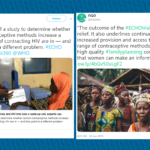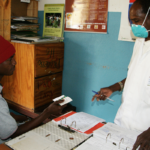This year, we at R&E Search for Evidence collaborated with 35 colleagues to publish 52 blog posts. Readers from 182 countries visited the blog to learn about research methods and findings from across the development spectrum, including HIV, education, family planning, gender, food security and more. I highlight some of our most popular posts and prolific authors in this final post of the year.
Most popular posts
At the top of the podium sits Annette Brown! Readers really like her post about bringing theory back to theory of change which we cross-published with 3ie. The ideas in Annette’s post formed the foundation of a workshop at the What Works Global Summit and American Evaluation Association conference.
Is it possible to take two seats on the podium? Annette also lands in second place by asking, “do I write like a girl?” She hopes so, because a new study shows women grant proposal applicants are more likely to use specific (read: innovative) words compared to broad words. But how reviewers score those women may surprise you. In this original post, Annette examines new evidence on gendered outcomes in Gates Foundation grant proposal and scoring data.
Sharing the spotlight with Annette is Jacqueline Shieh. Jacqueline writes about new evidence from Bangladesh that shows one way to reduce household food insecurity is to integrate nutrition programming into existing antenatal care.
FHI 360 Library Manager Allison Burns wrote about finding the right journal for your research manuscript in 2017. This year, Allison helps answer another frequently-asked-question in our fourth most popular post. She summarizes her experience using a tool that matches your manuscript with an appropriate journal.
Emily Namey rounds out the top five this year. Research studies from the ASPIRES project aimed to address the economic needs impeding HIV prevention and treatment adherence by using a realist evaluation approach. Emily describes how the team used the approach to develop evidence across many projects.
Most prolific blog post authors
Annette Brown is easily this year’s most decorated blog post author (and I’m not just saying that because she is Editor-in-Chief!). She is not only the author of our most popular post, but she is also our most prolific author. Annette writes about push button replication, offers a new evidence map of ICT4D interventions (and a how-to post for understanding evidence maps), writes a book review of Raj Kumar’s The Business of Changing the World and more. Most recently, she examines the differences between public health and social science research – namely, how authorship differs and whether publication lags matter. Oh, and there’s more. Annette also hosts a series of Research Roundtable videos (there are five of them).
Emily Namey is our second most prolific author this year. You may know Emily from her immensely popular 2017 post about how many interviews and focus groups qualitative researchers need to achieve saturation. This post is so popular I jokingly call Emily the queen of the R&E Search for Evidence blog. This year, Emily writes about developing guidance for the integration of household economic strengthening activities into family support programming and co-authors two posts about financial diaries. The diaries posts (here and here) describe how the high-frequency data collection methodology has been useful in her team’s research work with vulnerable groups.
Most shared on social media
I tweet every day about our R&E Search for Evidence posts (check us out on @fhi360research). Readers engage with our posts on Twitter and on the other FHI 360 social media platforms. Two posts stand out to me this year as particularly engaging.
Robyn Dayton and Betty Alvarez write about an HIV and gender-based violence (GBV) study in the Dominican Republic. Findings from the evaluation show integrating GBV services into an existing HIV program improves the quality of GBV services and increases engagement with HIV services like testing. The post is also available in Spanish.
Pharmaceuticals are often the first thing people think of when it comes to falsified and substandard public health products. However, other medical commodities can suffer quality problems too. David Jenkins writes about how FHI 360 conducted quality control testing of male condoms in the Dominican Republic after local concerns. Those findings led to local regulators removing poor-quality condoms from the market.
Countries with the most readers
Half of our readers are based outside the United States, so here are the top five countries with the most readers and what they find most popular.
United Kingdom
Readers in the U.K. like Katherine Whitton’s post on girls’ education and early marriage. Katherine writes about qualitative evidence on child marriage from Ethiopia and India. Additionally, Annette’s book review of Ann Mei Chang’s Lean Impact features high on the U.K. list. The review also offers Annette’s thoughts on science and the scientific method.
India
Hand hygiene is at the top of readers’ minds in India. Need proof? The Global Handwashing Partnership’s Aarin Palomares secures both of the top spots. First, Aarin discusses whether hygiene-specific sensing technology is a superior alternative for improving hand hygiene in health care settings. Second, Aarin writes about how behavior change efforts can use nudges, specifically handwashing nudges, to change habits.
Nigeria
Readers in Nigeria like Ishak Mohammed’s summary of new HIV case finding evidence. The study from Zimbabwe shows strong evidence of high HIV case finding through index testing and partner notification services work to identify new HIV cases. Additionally, Annette’s summary of peacebuilding evidence topped the list. She highlights a recent evidence review for violence reduction from the Alliance for Peacebuilding and a 3ie evidence gap map on building peaceful societies in the post.
Kenya
Judith Nalukwago and Tiffany Lillie piqued the interest of readers in Kenya. First, Judith describes her new research showing boys and girls approve of gender inequitable norms in Uganda – such approval leads to gender power imbalances and affects an individual’s ability to negotiate safe sex, especially adolescents. Next, Tiffany Lillie describes how an enhanced peer outreach approach worked in Burundi, Cote d’Ivoire and the Democratic Republic of Congo to reach key populations and ensure they knew their HIV status.
Philippines
Finally, readers in the Philippines like a methods post co-authored by me, Jacqueline Shieh, and Annette. We write about how a team of researchers encountered an unintended consequence then expanded their evaluation to learn more about why and how it occurred. Another popular post is Manisha Shrestha’s exploration of the determinants of stunting in Nepal. Nepal has achieved gains in reducing stunting among children under five years.
What’s the outlook for 2020?
We are already working hard to bring you more great content in 2020, including posts about discreet choice experiments, data visualization, a book review and research on maintaining programs during political transitions. Stay tuned!
Photo credit: Pixabay



